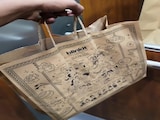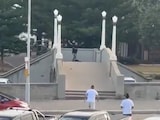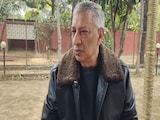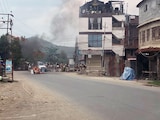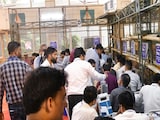New York:
Among the enduring images left by car bombings, overseas or in the United States, is investigators on their hands and knees, crawling through the wreckage searching for clues: a blasting cap or a timing device, a piece of the explosive's casing or a trace of the chemicals used.
Car bombs, by design, do their best to devour any evidence of their existence, or send it flying.
On Saturday in Times Square, a homemade bomb built inside a Nissan Pathfinder did not explode -- and as a result, a trove of evidence was left behind for investigators to pore over, not only for physical evidence or forensic clues, but also as a reflection of an assailant's methods, mind-set and possible motives.
"There is a lot there to read into the case that really helps them," said James M. Cavanaugh, a former bomb expert with the federal Bureau of Alcohol, Tobacco, Firearms and Explosives who investigated car bombs and tracked the Unabomber, Theodore J. Kaczynski, and Eric R. Rudolph, the bomber of abortion clinics and other sites.
Or, put another way by Kevin B. Barry, who retired in 2002 as a detective in the bomb squad of the New York Police Department and is now an official with the International Association of Bomb Technicians and Investigators: "He was trying to cover his tracks, but he left more clues than a guy walking into a bank to rob it without a mask. This guy left everything here but his wallet."
The evidence has yielded much: police detectives and F.B.I. agents, using the vehicle's identification number, have already located and spoken with its registered owner and learned that it was sold for cash two weeks ago in Bridgeport, Conn.
Like the 17-character identification number, each bit of material from the car or its insides will be traced to divine its provenance, investigators said.
And when the bomb in the Pathfinder did not go off, the authorities had not only the vehicle, but also the raft of explosive elements packed inside: two neon-color alarm clocks and the time one was set to, some batteries, two five-gallon gasoline containers, three propane tanks, firecrackers, fertilizer packed in clear plastic bags bearing a store's logo, a cooking pot and a 78-pound metal gun box, a GC-14P 14-gun steel security cabinet manufactured by Stack-On, the police said.
Moreover, a car is an ideal receptacle for microscopic or invisible traces of who might have been inside. The authorities have been dusting the outside of the Pathfinder for fingerprints. Inside, they can search for traces of hair or skin cells that might have sloughed off on a steering wheel or a seat cover. They may find literature tucked into a glove box, or some food under a seat.
Each clue will be its own mini-investigation, in an inquiry that is involving "hundreds" of officers and agents, said Deputy Commissioner Paul J. Browne, the Police Department's chief spokesman.
Mr. Cavanaugh, who retired last month from the federal agency, said: "You could have hair, fingerprints, the skin cells, DNA, blood. This is a great way to start. Of course, the world is not all 'CSI.' But once you get someone to look at, you can go back to see if they match what you've got, and that is a beautiful thing."
On Monday, Mr. Browne said that "some forensic evidence" had been developed, but he declined to say if it was fingerprints, DNA or something else that had been culled from the vehicle, or if literature had been found. "We are in the middle of a sensitive investigation," he said. "There are only so many things I can disclose."
"The fact that it was not destroyed was an opportunity to develop evidence from it," Mr. Browne said. "It led us to the registered owner, which was an important development." Finding the identification number "continues to pay dividends," he added late Monday.
In the broadest sense, Mr. Cavanaugh said, the device and the way it was designed speak to a "grandiose purpose."
It was apparently fashioned in short order and with seemingly common tools. The clocks were on the floor of the back seat area, and the plastic gas containers were on the rear seat, on either side of a 16-ounce canister with M88 firecrackers. Behind that, the three propane containers were arrayed, one with some firecrackers affixed to it. And behind that was the gun locker, inside a cardboard box, containing eight bags of nonexplosive fertilizer.
"I call this a Rube Goldberg contraption," Mr. Cavanaugh said.
"It's the 'swing-the-arm-with-the-shoe-that-hits-the-ball-and-knocks-over-a-stick-that-knocks-something-off-a-shelf,' " he said, "and it is all supposed to work."
It malfunctioned, for reasons that are still being pieced together, though Mr. Browne said the packet of M88s attached to one of the propane tanks went off partially, dispersing some of its force.
"I don't know for certain what the designer had in mind," Mr. Browne said.
Some psychology is also involved, Mr. Cavanaugh said, as investigators must be imagining what the bomber or bombers were thinking. "I can tell you that they thought it was the atomic bomb," he said. "They have more desire than ability."
Car bombs, or "vehicle-borne improvised explosive devices," can have a range of effects on what evidence is left behind, depending on how the vehicle is situated and what materials are used, said an explosives expert who dealt with bombs in the United States Marine Corps but declined to be identified by name.
In the 1996 truck bomb attack on the Khobar Towers complex in Saudi Arabia , which killed 19 American airmen, the explosion could have been even more devastating if the truck had been parked alongside the complex, rather than backed into it.
Mr. Barry recalled a Manhattan car bomb from the 1970s that blew the hood onto a building's roof 21 stories high.
Sometimes, streets and sewers must be searched for blocks.
Having the Nissan intact in this case, the former military analyst said, was a good thing.
Car bombs, by design, do their best to devour any evidence of their existence, or send it flying.
On Saturday in Times Square, a homemade bomb built inside a Nissan Pathfinder did not explode -- and as a result, a trove of evidence was left behind for investigators to pore over, not only for physical evidence or forensic clues, but also as a reflection of an assailant's methods, mind-set and possible motives.
"There is a lot there to read into the case that really helps them," said James M. Cavanaugh, a former bomb expert with the federal Bureau of Alcohol, Tobacco, Firearms and Explosives who investigated car bombs and tracked the Unabomber, Theodore J. Kaczynski, and Eric R. Rudolph, the bomber of abortion clinics and other sites.
Or, put another way by Kevin B. Barry, who retired in 2002 as a detective in the bomb squad of the New York Police Department and is now an official with the International Association of Bomb Technicians and Investigators: "He was trying to cover his tracks, but he left more clues than a guy walking into a bank to rob it without a mask. This guy left everything here but his wallet."
The evidence has yielded much: police detectives and F.B.I. agents, using the vehicle's identification number, have already located and spoken with its registered owner and learned that it was sold for cash two weeks ago in Bridgeport, Conn.
Like the 17-character identification number, each bit of material from the car or its insides will be traced to divine its provenance, investigators said.
And when the bomb in the Pathfinder did not go off, the authorities had not only the vehicle, but also the raft of explosive elements packed inside: two neon-color alarm clocks and the time one was set to, some batteries, two five-gallon gasoline containers, three propane tanks, firecrackers, fertilizer packed in clear plastic bags bearing a store's logo, a cooking pot and a 78-pound metal gun box, a GC-14P 14-gun steel security cabinet manufactured by Stack-On, the police said.
Moreover, a car is an ideal receptacle for microscopic or invisible traces of who might have been inside. The authorities have been dusting the outside of the Pathfinder for fingerprints. Inside, they can search for traces of hair or skin cells that might have sloughed off on a steering wheel or a seat cover. They may find literature tucked into a glove box, or some food under a seat.
Each clue will be its own mini-investigation, in an inquiry that is involving "hundreds" of officers and agents, said Deputy Commissioner Paul J. Browne, the Police Department's chief spokesman.
Mr. Cavanaugh, who retired last month from the federal agency, said: "You could have hair, fingerprints, the skin cells, DNA, blood. This is a great way to start. Of course, the world is not all 'CSI.' But once you get someone to look at, you can go back to see if they match what you've got, and that is a beautiful thing."
On Monday, Mr. Browne said that "some forensic evidence" had been developed, but he declined to say if it was fingerprints, DNA or something else that had been culled from the vehicle, or if literature had been found. "We are in the middle of a sensitive investigation," he said. "There are only so many things I can disclose."
"The fact that it was not destroyed was an opportunity to develop evidence from it," Mr. Browne said. "It led us to the registered owner, which was an important development." Finding the identification number "continues to pay dividends," he added late Monday.
In the broadest sense, Mr. Cavanaugh said, the device and the way it was designed speak to a "grandiose purpose."
It was apparently fashioned in short order and with seemingly common tools. The clocks were on the floor of the back seat area, and the plastic gas containers were on the rear seat, on either side of a 16-ounce canister with M88 firecrackers. Behind that, the three propane containers were arrayed, one with some firecrackers affixed to it. And behind that was the gun locker, inside a cardboard box, containing eight bags of nonexplosive fertilizer.
"I call this a Rube Goldberg contraption," Mr. Cavanaugh said.
"It's the 'swing-the-arm-with-the-shoe-that-hits-the-ball-and-knocks-over-a-stick-that-knocks-something-off-a-shelf,' " he said, "and it is all supposed to work."
It malfunctioned, for reasons that are still being pieced together, though Mr. Browne said the packet of M88s attached to one of the propane tanks went off partially, dispersing some of its force.
"I don't know for certain what the designer had in mind," Mr. Browne said.
Some psychology is also involved, Mr. Cavanaugh said, as investigators must be imagining what the bomber or bombers were thinking. "I can tell you that they thought it was the atomic bomb," he said. "They have more desire than ability."
Car bombs, or "vehicle-borne improvised explosive devices," can have a range of effects on what evidence is left behind, depending on how the vehicle is situated and what materials are used, said an explosives expert who dealt with bombs in the United States Marine Corps but declined to be identified by name.
In the 1996 truck bomb attack on the Khobar Towers complex in Saudi Arabia , which killed 19 American airmen, the explosion could have been even more devastating if the truck had been parked alongside the complex, rather than backed into it.
Mr. Barry recalled a Manhattan car bomb from the 1970s that blew the hood onto a building's roof 21 stories high.
Sometimes, streets and sewers must be searched for blocks.
Having the Nissan intact in this case, the former military analyst said, was a good thing.





